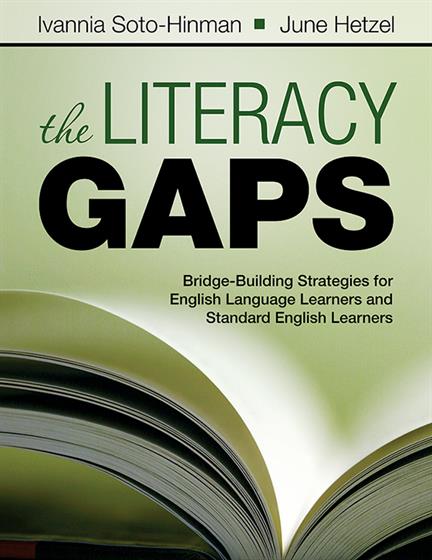
Hands-on, Practical Guidance for Educators
From math,
literacy, equity, multilingual learners, and SEL, to assessment, school counseling,
and education leadership, our books are research-based and authored by experts
on topics most relevant to what educators are facing today.
The Literacy Gaps
The authors provide strategies, examples, and tools to address the gap between ELLs and texts, socio-cultural differences between teachers and ELLs, and language differences between ELLs and peers.
- Grade Level: PreK-12, Elementary, Secondary
- ISBN: 9781412975216
- Published By: Corwin
- Year: 2009
- Page Count: 272
- Publication date: June 11, 2012
Price: $43.95
For Instructors
When you select 'request review copy', you will be redirected to Sage Publishing (our parent site) to process your request.
Description
"The book makes a contribution to the education of English language learners. It provides practical instructional suggestions for teachers of both ELLs and SELs that are informed by a deep understanding of theories of second language and second dialect acquisition and the development of reading and writing proficiencies."
—Guadalupe Valdés, Professor of Education
Stanford University
"The concepts of gaps and bridges are clearly articulated up front and provide a well-structured theme that unites the various parts of the text. The use of this structure provides a logical and coherent mechanism for providing a complete picture of the problem—the literacy gap between ELs and native speakers—and a means for addressing this problem."
—Kristina Anstrom, Senior Research Scientist
The George Washington University Center for Equity and Excellence in Education
Build bridges of support so English language learners can learn alongside their peers!
English language learners (ELLs) and standard English learners (SELs) face multiple gaps as they strive to achieve, so educators need to take a holistic, comprehensive approach to bridge those gaps and meet the needs of ELLs and SELs in the classroom.
Based on an original, well-researched framework, this much-needed resource provides practical strategies for supporting learning and success for ELLs. The authors provide strategies, examples, and classroom tools to address:
- The gap between students and texts: covering word recognition, background knowledge, comprehension, and academic language development
- The gap between students and teachers: including socio-cultural differences between teachers and students, and teacher perceptions and expectations
- The gap between students and their peers: discussing language proficiency differences, grouping strategies, and grade-level and schoolwide programs
The Literacy Gaps helps educators give ELLs the skills they need to close the most important gap of all: the achievement gap.
Key features
- The book is designed around an original conceptual framework that describes three gaps facing English language learners (ELLs)—gaps between the learner and the text, between the learner and the teacher, and between the learner and his/her peers
- The authors provide an array of practical strategies for bridging the three gaps and meeting the needs of ELLs in the classroom
- Each strategy is accompanied by a classroom example and a thorough explanation of effective classrom implementation
- Templates of conversational guides enable the reader to "hear" supportive, scaffolded language between instructor and students
Author(s)

Ivannia Soto
Soto has authored and coauthored 12 books, including The Literacy Gaps: Bridge-Building Strategies for English Language Learners and Standard English Learners; ELL Shadowing as a Catalyst for Change, a best seller that was recognized by Education Trust–West as a promising practice for ELLs in 2018; Moving From Spoken to Written Language With ELLs; the Academic English Mastery four-book series; the Common Core Companion four-book series for English language development; Breaking Down the Wall; and Responsive Schooling for Culturally and Linguistically Diverse Students. Together, the books tell a story of how to equitably engage and include multilingual learners by ensuring that they gain voice and an academic identity in the classroom setting. Soto is executive director of the Institute for Culturally and Linguistically Responsive Teaching (ICLRT) at Whittier College, whose mission it is to promote relevant research and develop academic resources for ELLs and Standard English learners (SELs) via linguistically and culturally responsive teaching practices/

June Hetzel
With 30 years in education, Hetzel remains passionate about literacy. She facilitates local volunteer tutoring partnerships and she and her husband, Geoff, enjoy leading teams of literacy teachers overseas to work with English language learners. A long-time member of the International Reading Association and the Delta Kappa Gamma Society International, Hetzel has authored many literacy resource books and currently freelances for Purposeful Design Publications, serving as a content editor for two textbook series, including the English as a Foreign Language series. She earned her MS in reading education from Cal State Fullerton and her PhD from Claremont Graduate University.
Table of Contents
Acknowledgments
About the Authors
1. Introduction to the Achievement Gap and the “Literacy Gaps Model”
Demographic Patterns
Language Spoken and Socioeconomic Factors
ELL Achievement
Standard English Learners
The National Literacy Panel
The Literacy Gaps Model
Overview of Book Chapters
Summary
2. Decoding: Word Recognition Strategies and Fluency
Introduction
The Gap Between the Student and the Text
Decoding and Readability of Text
Decoding
English Language Development
Background Knowledge
Summary
3. Background Knowledge and Experiences
Schema Fit: Becoming a Text Participant
Context: Becoming a Text User (Active Participant)
Linkages: Becoming a Text Analyst (Reading Critically)
Summary
4. Comprehension
Comprehension Gap
Academic Language
Passage Comprehension
Summary
5. English Language Development and Academic English
Specialized Language Needs of ELLs
Needs of Standard English Learners
Academic Language Development Lesson Plan
Summary
6. Perceptions and Expectations
Were Called on Less Frequently and Were Provided Less Time to Respond
Were Given the Answer Rather Than Helped to Solve the Problem Themselves
Were Criticized More Often, and Praised Less
Were Paid Less Positive Attention, but Disciplined More Strictly
7. Cultural Differences
Connecting the Literacy Domains in Second Language Acquisition
Parental Involvement and the Literacy Domains
Culturally Responsive Teaching
Comprehensive Education
Multidimensional Approaches
Empowerment
Transformative Learning
Emancipatory Education
Summary
8. Socioeconomic Differences
Implicit and Explicit Codes
Discourse Patterns
Interactional Styles
Written Language Codes
Resource Access
Summary
9. Language Variables
Academic Language Competence
Summary
10. Grouping Strategies
Micro Structures That Bridge Language Proficiency Gaps
Macro Structures That Bridge Language Proficiency Gaps
Summary
11. Beyond the Gap/Envisioning the Future
The Literacy Gaps Model
Summary
Glossary
Index
Reviews
"The book makes a contribution to the education of English language learners. It provides practical instructional suggestions for teachers of both ELLs and SELs that are informed by a deep understanding of theories of second language and second dialect acquisition and the development of reading and writing proficiencies."Guadalupe Valdes, Professor of Education
Stanford University
"The concepts of gaps and bridges are clearly articulated up front and provide a well-structured theme that unites the various parts of the text. The use of this structure provides a logical and coherent mechanism for providing a complete picture of the problem—the literacy gap between ELs and native speakers—and a means for addressing this problem."Kristina Anstrom, Senior Research Scientist
The George Washington University Center for Equity and Excellence in Education
"The strategies are clearly presented and there is just enough research cited to provide the rationale for incorporating ideas into instruction. Any teacher will find this book practical, and the discussions will provide meaningful ideas for study groups at the school site."Ron Klemp, Secondary Literacy Coordinator
Los Angeles Unified School District, CA
"This book presents content that is crucial for narrowing the achievement gap and powerful practical instructional strategies for increasing student achievement."Yee Wan, Coordinator, English Language Learners Program
Santa Clara County Office of Education
For Instructors
When you select 'request review copy', you will be redirected to Sage Publishing (our parent site) to process your request.

